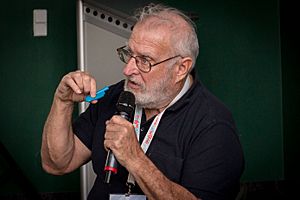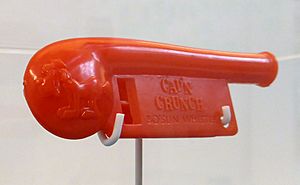John Draper facts for kids
John Thomas Draper (born March 11, 1943), known as Captain Crunch, is an American computer programmer. He was also a "phone phreak." This means he explored how telephone systems worked. His nickname came from a toy whistle found in Cap'n Crunch cereal boxes. This whistle could make a special sound that helped people understand how phone calls were routed.
Draper is a well-known person in the world of computer security and hacking. He is famous for his unique and interesting role in the history of Silicon Valley. He became friends with and influenced Steve Wozniak and Steve Jobs before they started Apple Computer. John Draper was very skilled at figuring out how the telephone network operated. His activities sometimes led to legal problems.
In the 1970s and 1980s, he worked as a software engineer for companies like Apple and Autodesk. He also had his own software company, where he created the EasyWriter word processor.
Contents
Early Life and Discoveries
John Draper is the son of an engineer who worked for the United States Air Force. When he was a child, he built his own radio station at home. He used old parts from military equipment to create it.
In 1964, Draper joined the U.S. Air Force. While he was stationed in Alaska, he helped other service members. He found a way for them to make free phone calls home using a local telephone switchboard. Later, in 1967, he started a pirate radio station in Maine called WKOS.
After leaving the Air Force in 1968, he moved to San Jose, California. He worked for different technology companies. He also studied part-time at De Anza College. During this time, he was also an engineer and a disc jockey for a radio station in Cupertino, California.
Exploring Phone Systems
What is Phone Phreaking?
John Draper learned about "phone phreaking" in 1969. Phone phreaks were people who explored the telephone network. They wanted to understand how it worked. Many of them were blind and had amazing hearing. They could use sounds to control the phone system.
One famous phone phreak was Joseph Engressia, known as Joybubbles. He could whistle a very specific sound, a 2600 hertz tone. This tone was used by the phone company AT&T to signal that a phone line was ready for a call. Phone phreaks would use this tone to make free long-distance calls. They would gather around payphones and play the tones into the receiver.
Draper learned that a toy whistle from Cap'n Crunch cereal boxes made the exact 2600-hertz tone. This whistle became very famous among phone phreaks. It helped them explore the phone network.
Building Blue Boxes
Draper was asked to build a special device called a "blue box." This device could make the 2600-hertz tone and other sounds. These sounds were used to control the phone network. Draper built his first blue box, and then designed a more advanced one.
By 1970, phone phreaking became more popular. Enthusiasts would connect on a special conference call system. They called it "2111." During one of these calls, John Draper got his nickname, Captain Crunch. It was inspired by the toy whistle.
After 1980, new technology made these whistles and blue boxes less useful. Today, the whistles are seen as cool souvenirs from that time. A magazine called 2600: The Hacker Quarterly is even named after the 2600-hertz tone.
How John Draper Influenced Others
In 1971, a journalist wrote an article about phone phreaking. The article focused a lot on John Draper. It made him somewhat famous among people interested in technology. Draper believed that his actions were about learning how systems work. He said, "If I do what I do, it is only to explore a system. Computers, systems—that's my bag."
This article caught the attention of Steve Wozniak, who was a student at the University of California, Berkeley. Wozniak met Draper to learn about building blue boxes. Wozniak's friend, Steve Jobs, was also there. Wozniak and Jobs later sold blue boxes. In 1976, they went on to create Apple Computer.
Legal Challenges
Because of the article, John Draper faced legal issues in May 1972. He was accused of making unauthorized long-distance calls. He received a suspended sentence and a fine. He was also told not to share his technical knowledge about making free calls.
Later, in 1975, Draper faced more legal problems. He was accused of using phone company technology to listen in on calls. He agreed to help the FBI understand phone system weaknesses and how to fix them.
In 1978, Draper faced more charges. He spent time in a Pennsylvania jail. This also affected his earlier legal agreement. In 1979, he was sentenced to a work program. He spent nights in jail and days working on computer code. This work led to the creation of EasyWriter.
Software and Hardware Development
Creating EasyWriter
While in a work-release program in 1979, Draper developed EasyWriter. This was the first word processor for the Apple II computer. He was inspired by other early word processors.
Later, EasyWriter was adapted for the IBM PC. IBM chose it as the official word processor for their new computer. This happened after they couldn't make a deal for another popular program. While the Apple II version was liked, the IBM version had some issues.
Draper started his own software company called Capn' Software. However, it did not make a lot of money. Another company later created a follow-up program, Easywriter II, without Draper's knowledge. This led to a legal dispute that was later settled.
Work at Apple Computer
In 1977, Draper worked for Apple as an independent contractor. Steve Wozniak asked him to create a device to connect the Apple II computer to phone lines. Wozniak thought computers could act like answering machines. Modems were not common yet.
Draper designed a device called the "Charley Board." It was meant to dial special phone numbers used by companies. It could also make tones to access their phone lines. In theory, this would allow free long-distance calls. When Apple's CEO learned about this, the project was stopped. However, some of the ideas from the Charley Board were later used in other phone services.
Wozniak said that the Charley Board was "incredible." He also mentioned that not everyone at Apple liked Draper, but he did.
Other Projects
Draper joined Autodesk in 1986. He designed software for video displays. In 1987, he faced charges related to creating fake tickets for the Bay Area Rapid Transit system. He pleaded guilty to lesser charges and entered a program. He was later fired from Autodesk.
From 1999 to 2004, Draper was a chief technical officer for ShopIP. This company designed a firewall device called The Crunchbox GE. A firewall helps protect computers from online threats. Even with support from Wozniak, the product did not become a big success.
In 2007, Draper became the chief technology officer of En2go. This company developed tools for delivering media. It is not clear when his involvement ended. The company did not achieve commercial success.
Autobiography
In 2018, John Draper wrote his autobiography, Beyond the Little Blue Box, with C Wilson Fraser. The book shares Draper's experiences with phone phreaking. It also talks about his contributions to early hacking culture. Steve Wozniak wrote the introduction for the book.
See also
 In Spanish: John Draper para niños
In Spanish: John Draper para niños



